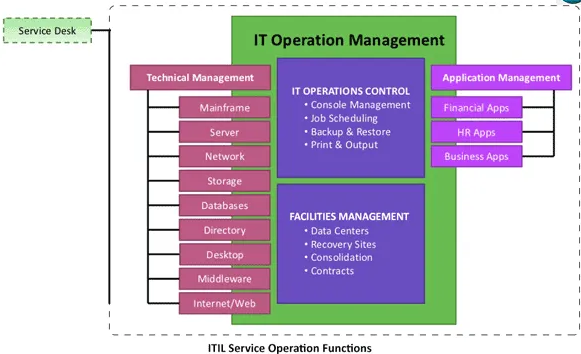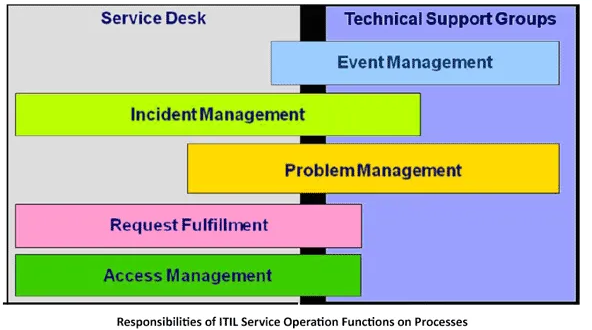We work with the ITIL strategy. We are ITIL® certified

Key Aspects and Benefits of ITIL Service Operation:
Below lists some of the key benefits of ITIL Service Operations process group:
- Reduce unplanned expenditure for both the business and IT through optimized handling of service outages and identification of their root causes.
- Allow an organization to take full advantage of a service by reducing the duration and frequency of service outages.
- Provide operational results and data that can be used by other ITIL processes to improve service quality.
- Support the organization’s security policy by ensuring that IT services will be accessed by authorized personnel only.
- Provide quick and effective access to standard IT services, required to improve the productivity & quality of staffs and products.
- Provide a framework for automating the iterative operations, which helps to increase the efficiencies and allows expensive human resources to be engaged in more innovative work, such as designing new or improved services, or making strategic changes in business etc.
ITIL Service Operation Processes and Functions:
As per ITIL 4, the Service Operations (SO) module consists of Five Processes, Four Functions, and Two Sub-Functions.
Below are the objectives and short descriptions of those Service Operations Processes, followed by a diagram showing the interrelationships between those processes and functions:
ITIL Service Operation Processes:
The Five Processes of Service Operations are:
1) Event Management:
Ensure that CIs and services are constantly monitored. It also filters and categorizes events to decide the appropriate actions needs to be taken.
2) Incident Management:
Responsible for restoring the IT service to working state quickly as possible, in case any unexpected event.
3) Request Fulfillment:
Responsible for acknowledging & processing Service Requests received from users. It generally deals with Standard Changes (e.g. requests to change a password) or requests for information.
4) Problem Management:
This process deals with finding the root cause of a problem. This process is used to prevent Incidents from happening or to minimize the impact of incidents that cannot be prevented.
5) Access Management:
Used to grant authorized users the right to use a service. Also blocks any access request of non-authorized users to the service. It follows the policies defined in Information Security Management.

ITIL Service Operation Functions:
The Four Functions & Two Sub-Functions of ITIL Service Operation are described as follows. Also showing a diagram explaining how they overlap in their working:
1) Service Desk:
Service Desk is the first and single point of contact. It is responsible for managing logged tickets, coordinating between end user and IT service provider team. It plays a significant role in maintaining customer satisfaction by ensuring timely closure of user requests.
2) Technical Management:
It provides technical expertise and support for the management of the IT infrastructure.
3) IT Operations Management:
This function is responsible for managing organization’s day-to-day operational activities related to Information Technology. This function has two sub-functions within it.
3.1) IT Operations Control:
This is a sub-function of IT Operations Management, responsible for monitoring and controlling the IT services and their underlying infrastructure. This function executes day-to-day routine tasks related to the operation of infrastructure components and applications. For example:- job scheduling, backup and restore etc.
3.2) Facilities Management:
This is a sub-function of IT Operations Management, which manages the physical environment where the IT infrastructure is located. It deals with all the aspects of physical environment, such as power, cooling, building access etc
4) Application Management:
This Function is responsible for managing applications throughout their lifecycle.

The Responsibilities of executing five processes of the ITIL Service Operations are assigned to two major functional groups. One is Service Desk and another is Technical Support Group (Includes Technical, Application, and IT Operations Management).
The below image describes the level of responsibilities each of the service operation functions has to take for the service operations processes to execute successfully:

Important Terminologies and Definitions:
Below lists some of the important terminologies and definitions we required to know before we proceed deep into the individual processes and functions of ITIL Service Operation module:
Function:
- A function is represented by “a group of people (or roles) and automated measures” that execute a defined process, an activity or combination of both.
- The functions are needed in order to maintain a stable IT operational environment.
- The IT Functions are used to define different roles and responsibilities required to maintain the overall Service Delivery and to Support IT Services.
Impact:
- Impact means the level of effect of an Incident, Problem or Change on Business Processes.
- It describes how Service Levels will be affected by those events.
Urgency:
- The measure of business criticality of an Incident, Problem or Change in terms of their effect on business deadlines.
Priority:
- The scale of time within which actions are to be taken in case of any deviation in service.
- Priority is a function of Urgency and Impact, i.e. Priority = Urgency * Impact.
Service Request:
- It is a request for accessing any service or information raised by the user.
Event:
- A notification created by a service, CI or monitoring tool.
Alert:
- A high priority warning or notice about the threshold, change or failure of a service or component.
Incident:
- Unexpected interruption or degradation in the quality of an IT service.
Problem:
- One or more similar Incidents for which root cause is unknown.
Workaround:
- A temporary solution provided to a user to overcome any issues or difficulties.
Known Error:
- Can be defined as a previously recorded problem for which now has a documented Root Cause & a Workaround.
Known Error Database (KEDB):
- It is a database consisting of previous knowledge of requests and known errors.
ITIL Service Operation Roles & Responsibilities:
Below are the Roles responsible defined under Service Operation (ITIL 4) module:
- IT Operations Manager
- IT Operator
- 1st Level Support
- 2nd Level Support
- 3rd Level Support
- Incident Manager
- Major Incident Team
- Service Request Fulfillment Group
- Problem Manager
- Access Manager
- Service Desk Manager
- Technical Analyst
- Applications Analyst